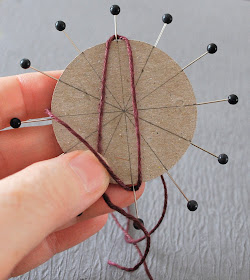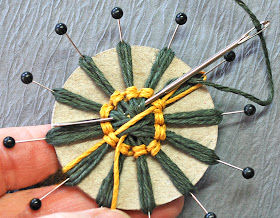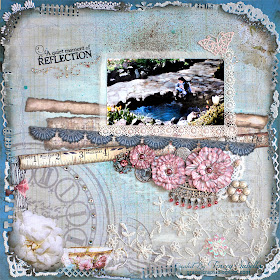Update March 2016: I now have a video tutorial for Girlie Grunge Twine Flowers showing how to create the loom and twine flower using Donna Salazar's new bakers twine for Scrapbook Adhesives by 3L. The process is exactly the same for jute twine or hemp cording. Only the size of the loom you use would change. A chart for suggested loom sizes and twine lengths can be found
HERE. (scroll to the bottom of that post for the chart) My
VIDEO TUTORIAL can be viewed
HERE.
Our son, Joseph, wrote a love letter to his bride, Rachel, and sent it to her with a rose while she was waiting for the wedding ceremony to start. This photo is of her reading his letter. The list are some of her responses to his love letter.

I have seen some fabulous twine flowers on Pinterest, but have not been able to locate a detailed tutorial to create them. After some experimenting, I've come up with these lovely gems and have written a step by step tutorial for you to recreate them as well.
Twine Flower Tutorial
***An updated version of my tutorial can be found HERE.***
Now I'd like to share a tutorial on how to make these beautiful twine flowers. I got the idea from a tutorial at
The Bug Bytes. I made several changes to her flowers, so I'm posting a tutorial here for my version of her twine flowers.
Please don't be intimidated by the number of steps. I wanted to make sure the directions are clear, so I would rather err on the side of giving you more information than you might need. The tutorial I learned from had fewer steps, and I found myself doing some trial and error, that hopefully will be avoided for you.
Once you have made your loom and have a couple flowers under your belt, these little beauties only take about 10 to 15 minutes each to create.
SUPPLIES:
a) Twine - any kind of thin hemp, jute, or baker's twine will work nicely ~ about 7 feet of twine for a 2 inch loom.
b) Two same size chipboard circles ~ I used 2 inch circles.
c) Glue ~ any kind of glue that will hold the two chipboard circles together will work. I used Scotch Quick Dry Adhesive.
d) 12 Straight pins ~ Mine have plastic balls on the ends, but any pins you have will work or even small finishing nails if you don't have straight pins.
e) Large eye tapestry or yarn needle The needle doesn't have to be flat on the end with a curve like mine, as long as the eye is large enough to thread the twine and a rounded rather than sharp pointed end, it will work.
f) A pencil or pen and ruler (not pictured) are needed to draw lines on the top circle.

MAKING THE LOOM:
Step 1. Cut two identical chipboard circles ~ I used 2 inch circles cut on the AccuCut machine at my LSS. They could also be traced and cut with scissors. Don't worry if your circles aren't exactly perfect. The petals aren't going to be exactly the same even with perfect circles. St
Step 2. Draw 6 lines evenly spaced on the front of one circle ~ This will give spacing like the numbers on a clock.
Step 3. Spread glue on the back of the circle you drew lines on and adhere to the other chipboard circle.
Step 4. Once the glue is dry, push your pins between the cardboard pieces in line with your pencil lines. If you don't let your glue dry first, a pair of pliers will be needed to pull your pins out the first time. (Go ahead, ask me how I know!!)
If you turn the chipboard on its side, it will look like this:
***Note*** My loom has held up well. I've made over 20 flowers, and the pins are still nice and tight.
MAKING THE TWINE FLOWERS:
Step 1. At first you will be working from your spool of twine. Don't cut anything yet. Think of your loom like a clock. Leaving about a 4 inch tail, hold the twine at 7:00. Wrap the twine up to the left side of the pin at 12:00 and wrap over and behind the 12:00 pin, moving from left to right, then wrap straight down to the right side of the pin at 6:00. Wrap the twine behind the 6:00 pin from right to left.
Step 2. Now wrap your twine back up to the left side of the 11:00 pin, wrapping over/behind the pin from left to right and straight down to the right side of the 5:00 pin, wrapping behind the 5:00 pin from right to left.
Step 3. Continue this pattern until you have one loop around each pin.
Step 4. Continue wrapping around the pins in the same pattern until you have two loops around each pin.
Step 5. This was the confusing part for me, so I changed out the twine to a contrasting color to help illustrate the remaining steps. Your final wrap will be back around the 7:00 pin where you started. My loom is rotated in the photo, so it is no longer in the 7:00 position, but this last wrap goes around the pin that was in the 7:00 position when you started wrapping.
You will leave the starting tail at the 7:00 pin. On the working end of your twine, cut about a 20 inch length of twine. That's 20 inches from the last wrap on the loom. The amount of twine needed will depend on the thickness of the twine you are using. A thicker twine will require more and a thinner twine would require less. The twine I used is about the thickness of bakers twine. I also made a flower with a thicker jute which you can see in the photo at the end of this tutorial. That twine required about 24 inches to do the center weaving in the flower. When it doubt, cut a longer piece that you think you might need and then you will know how much to cut for your next flower.
Thread the twine onto your large needle.
Step 6. Now you are going to start weaving around the center of the flower. This will secure the flower petals in place and give the decorative stitching around the flower center. You are working from the back of the flower, so you won't see the pretty decorative stitching until the end when you remove your flower from the loom and turn it over.
Move your 7:00 pin so it is now at 12:00. You will start weaving behing the "petal" to the right of your final wrap. So, take your needle and go underneath the 4 strands of twine wrapped around the 1:00 pin and push the needle all the way behind the 5 strands at the 12:00 pin, (the 4 petal strands and your starting strand of twine - this is the only place there will be 5 strands of twine.) As you can see on the photo, your needle will be under a total of 9 strands of twine.
Step 7. Pull your needle through. For this weaving stitch only leave a little slack in the end of your twine. Notice what the yellow twine is doing.
The last wrap around the pin is now at the 12:00 position only goes to the center of the flower, so when you take your next weaving stitch with your needle you will secure that half thread in place. Moving to your left, push the needle under all 4 strands of the 12:00 petal plus starting tail and keep pushing it under the 4 strands of the 11:00 petal.
Step 8. Pull your woven stitches tight, pushing them towards the center of the flower with the tip of your needle. This is the only place where you may need to work with your stitches a little bit to get them nice and tight. Sometimes after I pull the stitches tight, the first stitch is too loose, if that is the case, I use my fingers to pull on the second stitch to take the slack out of the first stitch. Your stitching should look like the stitches in the photo below.
Step 9. Continue weaving by stitching under the petals, moving to the left in a counter clockwise direction. Please note, now that you are past the starting tail at the 12:00 petal, you will continue going behind two petals each time, but now for a total of 8 strands of twine.
Step 10. Continue this pattern until you have 2 stitches around each petal, coming back around to where you started. Your last weaving stitch will still go behind 2 petals ~ 8 strands of twine. Pull the working twine on your needle down between the petals and between the stitches to the center of the flower.
Notice how the yellow twine in the photo is pulled to the center of the flower between the 12:00 and
1:00 pins.
Step 11. Use your needle to weave the end of the thread under the top layer on the center stitches until it seems secure. I take two to three stitches to secure, usually going under about 10 or so threads all together. I start the needle under a thread that is right where I am pulling the thread between the petals and stitching so I don't distort the woven design on the back side of the stitching, which will actually be the front of the flower. After weaving the end of the twine to secure, cut it close to where it is exiting the flower center.
Step 12. Pull the starting twine to the center and secure it in the same way.
Step 13. To release the flower from the loom, pull the pins out one at a time to release each petal, then put the pin back in place to be ready to create your next flower.
Turn your flower over to admire the beautifully stitched border around your center.
I created a 2-inch loom. You can change the size of your flowers by using different size circles, but keep in mind that the center of your flower will be determined by the thickness of your twine, and will stay the same regardless of what size circle you use. You can see that my jute flower has a much larger center than the twine flowers. If I make another jute flower, I will probably use a larger loom so it will look more daisy-like. Because this jute was thicker than the twine, the center turned out larger, giving more of a sunflower appearance.
You can also dress your flowers up with a button or other bling like I did for my layout or even layer them with other flowers.
I hope you give these flowers a try.
Here are a few more examples of how I've used these flowers in my projects:
Thanks for stopping by! I treasure your comments.
~ Blessings ~


















































